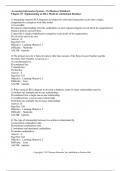Exam (elaborations)
Chapter 18 Implementing an REA Model in a Relational Database
- Institution
- Chapter 18 Implementing An REA
Chapter 18 Implementing an REA Model in a Relational Database Accounting Information Systems 12Th Ed by Marshall B. Romney - Test Bank
[Show more]



